If you have never experienced a meal prepared using a Dutch oven or cast iron cookware, then you are missing out. Cast iron is heavy and bulky so it doesn’t lend itself well to backpacking but for an overland trip where you can afford some of the extra weight and space its a versatile tool that can help you prepare a very wide range of meals. Cooking with a dutch oven and cast iron is a whole different world. Some of the key benefits are that you can prepare food with less oil, when properly seasoned it gives a non stick surface and its something that can (and does) last for generations.
I have had quite a bit of experience using a dutch oven from by background as an Eagle Scout but I didn’t have one as my own till my in-laws got one for me for Christmas 9 years ago. The cast iron got used quite a bit for the next five years but then military deployments and such forced me to leave my cast iron cookware in storage for about four years. Had I been an obsessive compulsive diligent person, I would have given it all a thorough cleaning and heavy seasoning before putting it all into storage. Instead, I was a bad man and I let out all go as is. Bad choice.
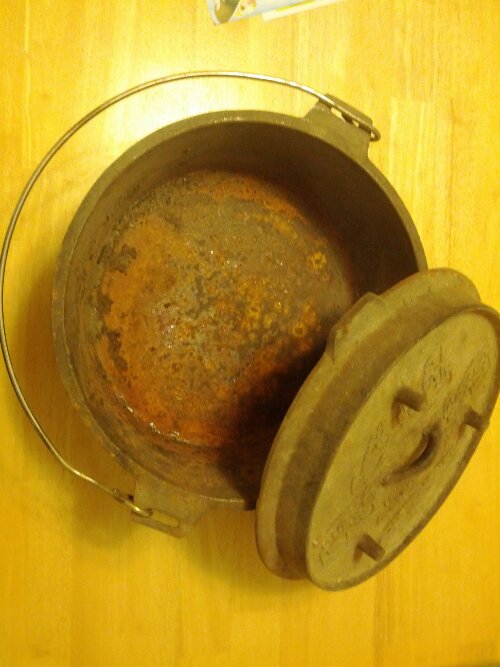
When I opened up my sad looking, dust covered, shredded nylon storage case for the dutch oven I was shocked at how bad things were. At first, I contemplated sending it all to the recycling center. Then my cheap frugal self decided it would be better to apply a heavy dose of TLC and elbow grease and try to recover it. My initial inspection revealed that the apparent damage was just really bad surface rust. I didn’t find any cracks so maybe this could be done. The next step was choosing my weapons to combat the steady onslaught of corrosion.
I did a lot of Googling research on how to remove rust and found a lot of recommendations. With the amount of damage I figured it try a few and see what worked best. After all, the damage had already been done; I couldn’t really make it any worse.
So here’s a list of my weapons for this battle:
• Vinegar
• Stiff bristle brush
• SOS pads/steel wool
• Electric drill motor and assorted wire brush wheels
I had read on a website that the vinegar would help remove rust so I gave it a try. I filled the lid and the oven with vinegar and let it sit for 24 hours. It certainly did something; I could tell that there was a chemical reaction taking place as seen by the bubbles, the slightly slimy feel and of course the smell of vinegar and…well something stinky. If you try this method, open a window and let some fresh air in. I dumped the vinegar down the drain and I could tell that it did help loosen up some rust, but it was far from enough to revive things. On to the next weapon.
Next, I tried a stiff bristle brush. That broke free some of the larger bits that were loosened up by the vinegar but again, it wasn’t quite enough to get the job done. And in the process, I think I ruined my wife’s dish washing brush. Oops!
Next up was the steel wool. This method was very effective! Basically, you just grab a pad and lean in hard while rubbing. Essentially, what you’re doing is taking the oven down to bare metal. You’ll notice that if you are using water to help clean the surface while you rub, that in a few short minutes, the oxidation process will begin again. I’d say that this method is best suited small spots rather than a full restoration job, like mine. I was pleased with the progress but I was channeling my inner Tim Taylor and this this job needed MORE POWER!
I went out to the garage, grabbed the first abrasive wire brush wheel I could get my hands on, tightened it into the chuck on my DeWALT drill and went to town. By the way, safety first! Wear some eye protection and hearing protection! Wire bristles will come loose and you do not want one of those stuck in your eye ball. Also, take this job outside so you don’t get oxidized dust all over the kitchen (again, sorry honey!) The only moisture involved in this process is in the air so any oxidation that takes place after the stripping process is minimal and can be wiped off easily with a paper towel. Despite the assistance of the drill in correcting my work to progress ratio, this still took quite a bit of time. But once it was all finished, I had a bare metal dutch oven that was ready for some seasoning!
Before adding any oil, it is important to wipe off as much of the dust as possible. Once you’re satisfied that the bare metal is clean, or you just give up, warm up your oven to 200 degrees and slide in your dutch oven. This will evaporate any moisture on the oven and prepare it for the first coat of oil. Leave the cast iron cookware in the oven for about an hour. Once that is completed you’re ready to start seasoning!
When I was in Boy Scouts it was common for people to just use Crisco and smear it all over the dutch oven to season it. But what I found is that you’ll have a slightly greasy residue when you’re finished. I was trying to achieve that nicely seasoned finish that is hard enough to provide some real wear resistance so I won’t have to go through this seasoning process again in the near future. The question then is, what do you use to season cast iron? There are lots of different opinions on the Internet (no surprise there) so finding the right substance was difficult and I’m still not sure that I got it right. You can get the seasoning in a bottle from your local sporting goods store but I wasn’t quite satisfied with the results that I’d seen. What really caught my attention was the scientific approach used by this website that I found: http://sherylcanter.com/wordpress/2010/01/a-science-based-technique-for-seasoning-cast-iron/ The bottom line up front is that the secret is all about the polymerization. Flax seed oil is said to provide the hardest, most non-stick finish possible and will give a nice long life to your cast iron cookware. Next question is, where can I buy flax seed oil? My answer is, I don’t know. But here, let me Google that for you… http://lmgtfy.com/?q=flax+seed+oil. This is what I ended up using though. http://www.barleans.com/flax-oil.asp. You’ll want to add enough oil to give the dutch oven a good coat and then wipe it off. Wipe it ALL OFF! You want to season your dutch oven in very thin layers to get the best results. Before you crank up your oven to 500 degrees you should consider laying down a sheet of aluminum foil across the rack to protect your heating coils from any potential drips. But you won’t have any drips because you wiped off ALL THE OIL, right?! Once your rack is covered crank up your oven to 500 degrees and set your dutch oven and lid in the oven. I placed my oven in upside down so that there wouldn’t be any potential for pools forming in the bottom of my dutch oven if I accidentally did get too much oil during any of the steps.
Let the cast iron bake for 60-90 minutes. After about 90 minutes, turned the oven off and let your cast iron set in the oven over night. What you are doing is letting the flax seed oil cure and harden. The next day, pull the cast iron out of the oven and inspect your work. The iron should be significantly darker. If the finished is tacky or sticky, then you either didn’t get the temperature high enough or you didn’t let it bake for long enough. The last key to a perfectly seasoned dutch oven is many thin coats of seasoning. When you’re ready for the second coats, crank your oven up to 500° while you wipe on another thing coats of oil. Remember again to wipe as much off as you can to ensure the layer is as then as possible. Bake it for another 60-90 minutes and then let it cool over night. I repeated the steps until I was pleased with the results, which ended up being six coats.
Since I have finished the seasoning I have used the cookware a few times and I am very pleased with the results. My eggs don’t stick to the surface. The flank steaks tasted amazing! And best of all, everything cleaned up easily! I have a long list of recipes to try out during this years camping season and I’m looking forward to enjoying all them around a camp fire out in the back country!
The last thing to consider now is how to store and transport your dutch oven. For the short version of the answer, I’ll refer you to my friend Matt over at http://www.blueridgeoverlandgear.com as he makes an outstanding dutch oven case that will protect your dutch oven from the abuse of a trail and protect your rig from the abuse of a heavy metal object bouncing around.
If you have a favorite dutch oven recipe idea love to hear about it! Leave your recipe in the comments below or send it to me at the4x4podcast@yahoo.com!


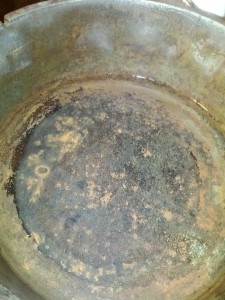
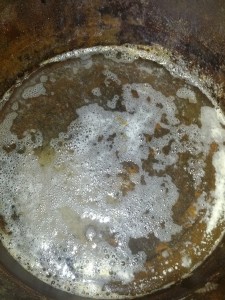
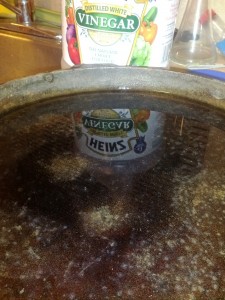
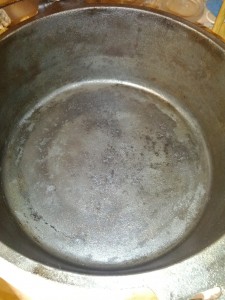
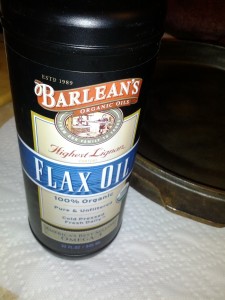
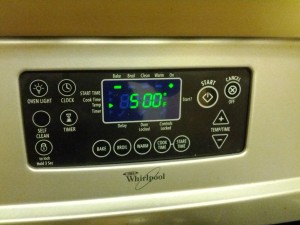
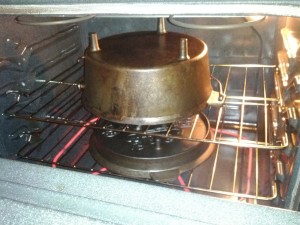
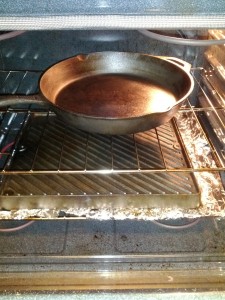
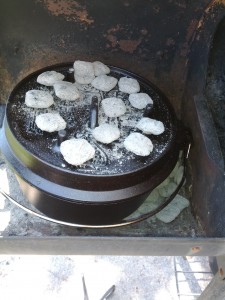
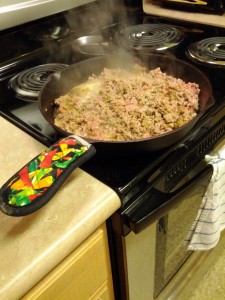

8 Responses to The Dutch Oven Revival